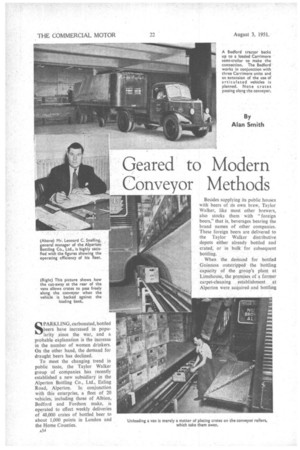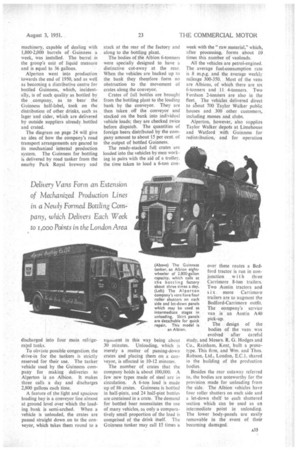Geared to Modern Conveyor Methods
Page 52

Page 53

Page 54

If you've noticed an error in this article please click here to report it so we can fix it.
By Alan Smith Delivery Vans Form an Extension of Mechanized Production Lines in a Newly Formed Bottling Company, which Delivers Each Week to i,00o Points in the London Area SPARKLING, carbonated, bottled beers have increased in popularity since the war, and a probable explanation is the increase in the number of women drinkers. On the other hand, the demand for draught beers has declined.
To meet the changing trend in public taste, the Taylor Walker group of companies has recently established a new subsidiary in the Alperton Bottling Co., Ltd., Ealing Road, Alperton. In conjunction with this enterprise, a fleet of 20 vehicles, including those of Albion, Bedford and Fordson make, is operated to effect weekly deliveries of 48,000 crates of battled beer to about 1,000 points in London and the Home Counties.
A34 Besides supplying its public houses with beers of its own brew, Taylor Walker, like most other brewers, also stocks them with "foreign beers," that is, beverages bearing the brand names of other companies. These foreign beers are delivered to the Taylor Walker distributive depots either already bottled and crated, or in bulk• for subsequent bottling.
When the .demand for bottled Guinness outstripped the bottling capacity of the group's plant at Limehouse, the premises of a former carpet-cleaning establishment at Alperton were acquired and bottling
machinery, capable of dealing with 1,800-2,000 barrels of . Guinness a week, was installed. The barrel is the group's unit of liquid measure and is equal to 36 gallons. Alperton went into production towards the end of 1950, and as well as becoming a distributive centre for bottled Guinness, which, incidentally, is of such quality as bottled by the ,company, as to bear the Guinness half-label, took on the distribution of other drinks, such as lager and cider, which are delivered by outside suppliers already bottled and crated.
• The diagram on page 24 will give an idea of how the company's road transport arrangements are geared to its mechanized internal production system. The Guinness for bottling is delivered by road tanker from the nearby Park Royal brewery and
discharged into four main refrigerated tanks.
To obviate possible congestion; the drive-in for the tankers is strictly reserved for their use. The tanker vehicle used by the Guinness company for making deliveries to Alperton i3 an Albion. It makes three calls a day and discharges 2,800 gallons each time.
A feature of the light and spacious loading bay is a conveyor line almost at ground level over which the loading bank is semi-arched. When a vehicle is unloaded, the crates are passed straight down on to the conveyor, which takes them round to a stack at the. rear of the factory and along to the bottling plant..
The bodies of the Albion 6-tonners were specially designed to have a distinctive cut-away at the rear. When the vehicles are backed up to the bank they therefore form no obstruction to the movement of crates along the conveyor.
Crates of full bottles are brought from the bottling plant to the loading bank by the conveyor. They are then taken off the conveyor and stacked on the bank into individual vehicle loads; they are checked twice before dispatch. The quantities of foreign beers distributed by the company amount to about 15 per cent: of the output of bottled Guinness.
The ready-stacked full crates are loaded into the vehicles by men working in pairs with the aid of a trolley. the time taken to load a 6-ton con
sigunient in this way being about 30 minutes. Unloading, which is merely a matter of passing-down crates and placing them on a conveyor, is effected in 10-12 minutes.
The number of crates that the company holds is about 100,000. A few new types made of steel are in circulation. A 6-ton load is made up of 86 crates. Guinness is bottled in half-pints, and 24 half-pint bottles are contained in a crate. The demand for bottled beer necessitates the use of many vehicles, as only a comparatively small proportion of the load is comprised of the drink itself. The Guinness tanker may call 15 times a week with the "raw, material," which, after processing, forms about 10 times this number of vanloads.
All the vehicles are petrol-engined. The average fuel-consumption rate is 8 m.p.g. and the average weekly mileage 300-350. Most of the vans are Albions, of which there are six 6-tonners and 11 4-tonners. Two Fordson 2-tonners are also in the fleet. The vehicles delivered direct to atout 700 Taylor Walker public houses and 300 other customers, including messes and clubs.
Alperton, however, also supplies Taylor Walker depots at Limehouse and Watford with Guinness for redistribution, and for operation over these routes a Bedford tractor is run in conjunction with three Carrimore 8-ton trailers. Two Austin tractors and si x more Carriinore trailers are to augment the Bedford-Carrimore outfit. The company's service van is an Austin A40 pick-up.
The design of the bodies of the vans was evolved after careful study, and Messrs. R. G. Hodges and Co., Rainham, Kent, built a prototype. This firm, and Wm. and Thos. Robson, Ltd, London, E.C.1, shared in the building of the production bodies.
Besides the rear cutaway referred to, the bodies are noteworthy for the provision made for unloading from the side. The Albion vehicles have four roller shutters on each side and a let-down shelf to each shuttered section which can be used as an intermediate point in unloading. The lower body-panels are easily removable in the event of their becoming damaged. The roof is made hollow to accommodate the roller shutters, which are not, as is usual, run up on rollers. House advertisements are painted on the shutters and as one surface is never rolled over another, neither the paintwork nor lettering suffer abrasion.'
Maintenance is chiefly carried out by outside garages, but routine checks are effected in the compapy's own service bay. A Laycock washer has recently been installed. If in the vicinity of the main Taylor Walker brewery at Limehouse, a driyer may bring his vehicle in for attention.
As in some other companies using the latest meansfor mechanical handling, the employees work with keenness and co-operation. Monthly works meetings are held with the general manager, Mr, L. C. Snelling, Minst.B.E., and complaints and suggestions are discussed.
In addition to being paid a good wage, the drivers receive Is. a day in lieu of a beer allowance, as is the practice with most other brewers. Drivers are provided with mackintoshes, and gumboots are available for their use when washing-down vehicles. Such co-operation between management and workers is reflected in figures which Mr. Snelling showed me of his fleet's efficiency. A daily schedule is kept showing tonnages handled in relation to the payload capacity of the vehicles. The figures are periodically collated and have so far shown that, on an average, nearly 100 per cent, of the total capacity of the fleet is utilized. Empty running is practically nil, as vehicles carry return loads in the form of empties, whilst the tractor-trailer combination is maintained in full service.
The modern plant in the factory has cut bottling costs to a minimum and the road transport system, which is virtually an outside extension of the production lines, is comparable with the inside organization both in respect of its mobility and economy.




















































































